Fruit Tree Placement & Planting Tips
You might know which plants are hardy for your USDA zone. But what about the specific conditions of your site? Will your fruit trees get enough light? Will they have enough moisture, or perhaps too much? This will impact your plant selections and relative placement.
- Where to Place & How to Plant Fruit Trees
- How Much Sun Do Fruiting Plants Need?
- How Much Water For Fruiting Plants?
- What Fruiting Plants are Salt Tolerant?
- What About Fruit Falling?
- How to Protect Fruit From Animals & Thieves?
- How to Plant Fruit Trees, Vines or Shrubs
Video: Urban Garden / Edible Landscape Tour
+ Backyard Orchard Plant & Book Ideas!
I've already changed quite a bit since my initial attempts at a backyard orchard. Every year things look better & better!
How Much Sun Do Fruiting Plants Need?
LIGHT LEVELS: What areas of your site receive good sun exposure? Examine your property at different times of the day and even at different points in the year. Pay careful attention to the shade of large overstory trees and man-made structures. Remember that large Winter shadows, might vanish in the Spring and Summer as the Sun's zenith reaches higher into the sky.
Most fruit bearing trees and shrubs will benefit from as much light as they can get, especially in temperate climates. Without sufficient sunlight, they may not set fruit. Or their fruit may not ripen well. On a small lot, the best place to consider is at the south of your home (northern hemisphere). Place your most prized, heat / sun loving specimens in this spot, if practical.
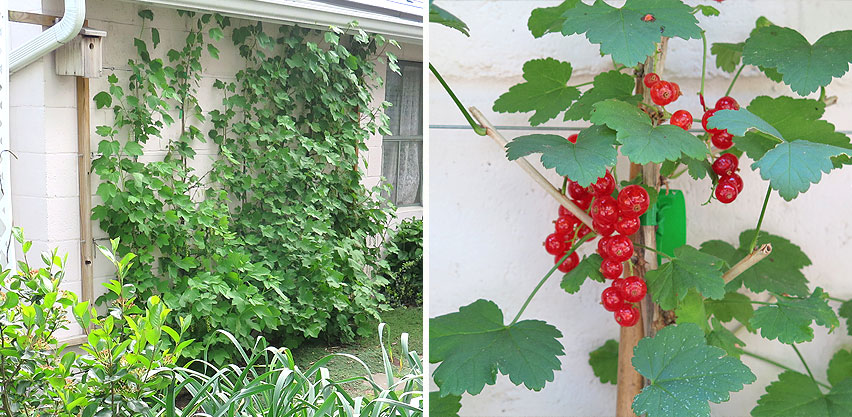
These red & white currant plants are well adapted to the shade of this northern wall.
Is most of your lot in a shady area? Then look for plants that can deal with this limitation. A popular option for shady areas are fruits from the ribes family. That includes red, white and black currants, gooseberries and jostaberries. Other fruiting shrubs include salal and evergreen huckleberry.
How Much Water For Fruiting Plants?
MOISTURE LEVELS: Precipitation rates and site drainage are serious considerations. Are you in a drought area? Does your lot have a perched water table or slowly draining soil? Select appropriate varieties and adapt your site as needed.
Identifying drought tolerant fruits can go a long way in improving the success of your backyard orchard. For example, jujubes or persimmons might be a good option for those hot dry climates. Once established, these fruit trees will require less water inputs than others.
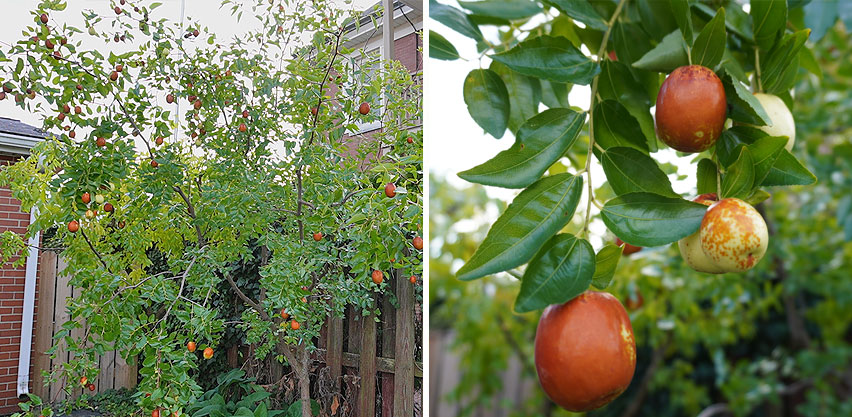
Jujubes are heat loving, drought tolerant trees that can produce fruit without extra irrigation.
Of course, some steps could be taken to amend your planting space. Adding organic matter can improve water retention. And thick mulch layers of 4 to 6 inches can greatly improve water conservation by reducing soil evaporation.
In wetter climates, you can select fruit trees that are grafted onto moisture tolerant rootstocks. In general, some varieties may be better adapted such as apples, pears or elderberries. Just watch that your plants are not sitting in a pooling basin. If a certain spot is plagued by poor drainage, consider mounding up a raised bed for your trees. This can go a long way to improve root health.
What Fruiting Plants are Salt Tolerant?
SALT SPRAY: This may not seem like a possible issue for you. Historically, salt stress was factor in maritime climates where the effects of ocean salts would impair plant cultivation. However, in many cold weather urban areas today, you will find that salts are routinely applied to roadways.
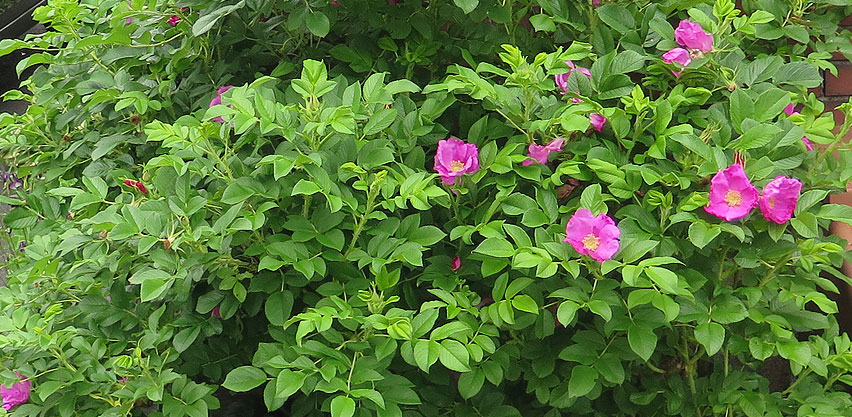
Rugosa roses are attractive vigorous bushes that grow well in salt-ridden locations.
The edges of your lot may be impacted by salt trucks that can throw salt several feet into your property. If this applies to you, it might be worth evaluating salt tolerant plants. Some native plants from both west and east coasts have been adapted to higher salinity levels. They might be a good fit for troublesome property edges. Of course, non-native plants can be highly beneficial as well. Examples of salt resistant edible plants include the beach plum, sea berry, rosa rugosa, goumi, kinnikinnick, evergreen huckleberry and salal.
What About Fruit Falling?
In small urban lots, backyard orchardists may try to squeeze every bit of production that they can out of their lot. That may include planting fruit trees and bushes along the very edge of a property. I've found this strategy to be crucial for maximizing fruit yield. But it does require a little forethought.
FALLING FRUIT: We want fruit. We want lots of fruit! But our neighbors might not appreciate OUR fruit falling on THEIR lawn. To mitigate issues, we might need to diligently prune back the growth that encroaches on adjacent lots. Special training of trees can go a long way in this regard. Look into espaliers and columnars for ideas on controlling your fruit trees.
This issue can cause more problems than we initially realize. Should we plant an apple tree along a road or alley where it may drop fruit onto passing cars? Would you want automobiles to be crushing your fruit as they drive by? Picture a driveway or sidewalk. Now imagine it littered with red or black mulberries. Think about the mess as people crush them under foot.
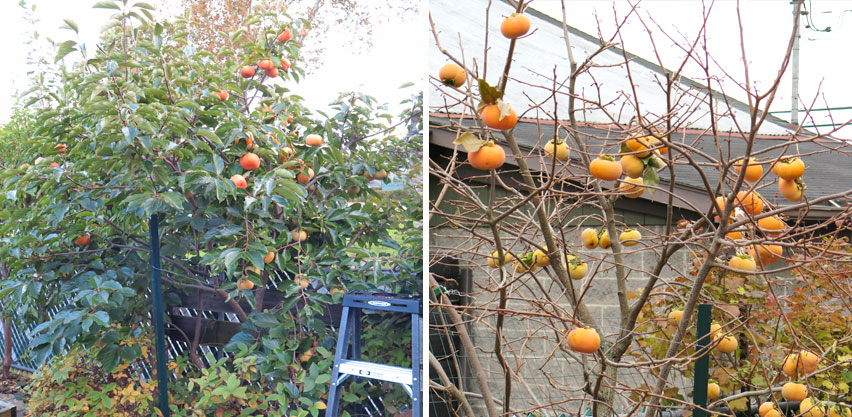
Even after the leaves have dropped, this Asian persimmon will still hold onto its fruit.
Switching varieties can help out. For example, a white mulberry won't stain everything if it gets trampled. Look for fruits that have a longer hanging time on the trees. They may stay in place for a while until picked off. Some types of persimmons are good for this. Consider non-astringent Asian persimmons, that can be picked and eaten while still crisp. Seaberries are notorious for holding on to their fruits. In general, think about smaller or less cylindrical fruits that won't roll into a street or sidewalk.
How to Protect Fruit From Animals & Thieves?
ANIMALS AND THEFT: Along property edges you are more likely to experience browsing by animals such as deer. This may not bother you. But if you don't want them destroying your precious harvest, then consider varieties that the deer dislike. Thorny plants like seaberries or hawthorns might be an option. In fact, some people have successfully grafted pears onto a hawthorn rootstock, creating a "deer-proof pear".
Wildlife might not be your primary concern. In some neighborhoods, human beings are a much larger threat. A passerby might be tempted to come steal all of your delicious fruit. So what should you do? Resist the urge to plant non-productive ornamentals. Planting a holly hedge might ensure that nobody steals your fruit. But it will 100% guarantee that you get zero fruit from that planting spot. I say roll the dice and hope for the best.
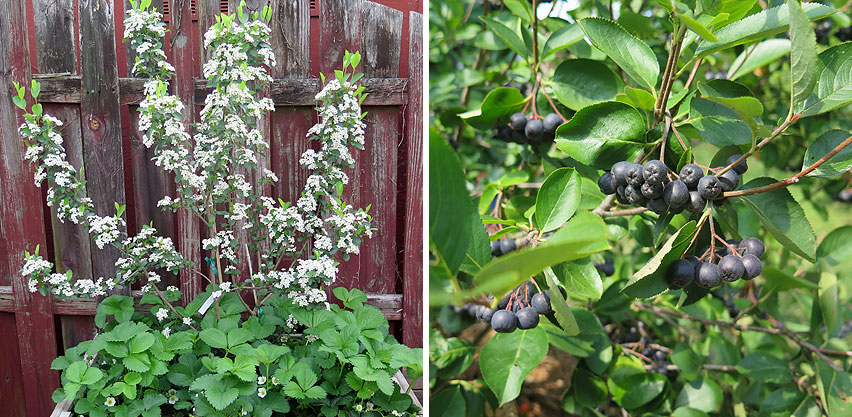
Aronia berries are high in anthocyanins, but they aren't good for eating out of hand like a blueberry.
One strategy is to capitalize on other people's ignorance and frivolity. If they see a bunch of peaches, they know what they are and those fruits will be easy pickings. But what about a nice aronia shrub? It's also called "choke berry" for a reason. Pick plants that look like ornamentals but offer more obscure harvests. Many people don't know what a goumi is or a huckelberry, oregon grape or high bush cranberry (viburnum trilobum). Some of these berries might not even taste that great out-of-hand. So the average brave forager, might be in for a tart surprise if the really do try sampling your edible landscape.
As a final note, consider the concept of gleaning. This ancient practice was once used as a way for people to share and display their generosity to others. Is it all that bad if some wildlife receives a little nourishment from your lot? And would sharing with your neighbors be such a bad thing either?
How to Plant Fruit Trees, Vines or Shrubs
POTTED vs BARE ROOT PLANTS: When selecting a new fruiting plant you might be faced with a choice between a potted plant or a bare root one. Potted plants are most common at local nurseries. Bare root plants are often a preferred means of shipping plants from online orders. Potted plants are advantageous because the plants can be stocked and sold all throughout the growing season. However, they often lead to root circling which impair natural root structure as the plant grows.
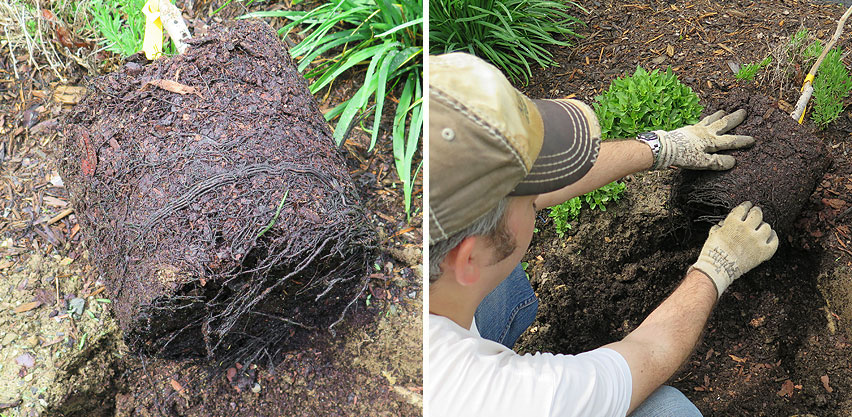
This potted Asian persimmon had significant root circling which needed to be loosened & straightened before planting.
Bare root plants eliminate concerns over root circling or girdling as plants mature. However, bare root plants are ordered and shipped within a very narrow time window. A plant must be in Winter dormancy to be packaged as a bare root. The root ball is dug up. The dirt is rinsed off and most of the small side roots are trimmed off. The tree or shrub is promptly planted once the ground is workable. Then as it breaks dormancy, the plant sends out a flush of new roots which are naturally structure in the native soil.

After planting this bare root dwarf cherry tree, I began training it during its first year of growth.
Both options are viable. But bare root plants often fare better in the long run. Ultimately I give greatest preference to selecting the exact cultivar that I'm looking for. If a potted version is all that I can find, I still go for it. When planting I at least try to tease the roots and straighten out any bad circling that I observe in the root ball.

![I'd Rather Be Planting Trees [Gardening T-Shirt Design] I'd Rather Be Planting Trees [Gardening T-Shirt Design]](images/I'd-Rather-Be-Planting-Trees_Gardening-Tshirt-Spreadshirt.jpg)
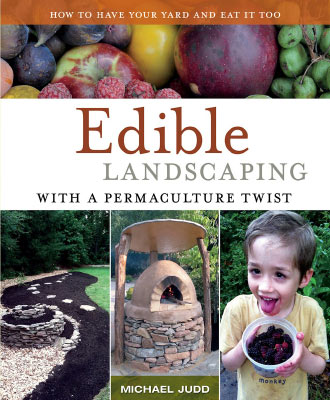
![Pre-Industrial Revolution CLIMATE CONTROL [Gardening T-Shirt Design] Pre-Industrial Revolution CLIMATE CONTROL [Gardening T-Shirt Design]](images/Pre-Industrial-Revolution-CLIMATE-CONTROL-carbon-sequestering_Gardening-Tshirt-Spreadshirt.jpg)